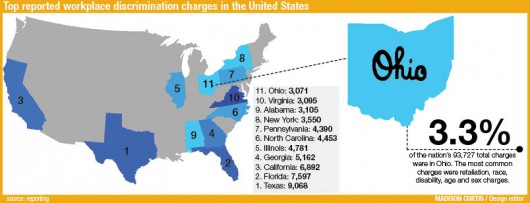Discrimination and harassment charges in Ohio workplaces decreased last year, according to the U.S. Equal Employment Opportunity Commission 2013 report.
EEOC’s report includes data from businesses with more than 100 employees, excluding federal contractors, to which different standards apply. Employers must legally provide the information, which is then compiled in the report and used for purposes like enforcement and research, according to the EEOC website.
In Ohio, 3,071 total charges were filed by individual employees with the EEOC in fiscal year 2013, down about 7.67 percent from 2012.
The majority of those discrimination charges dealt with retaliation, race, disability, age and sex, and complaints in Ohio made up 3.3 percent of the nation’s 93,727 total charges. Only 10 other states filed more charges to the EEOC in 2013 than Ohio.
According to the U.S. Census Bureau, Ohio had the seventh largest state population in 2010 with about 11.54 million residents.
But these 3,000-some cases likely don’t tell the whole story of workplace harassment and discrimination. The EEOC’s numbers only represent federal charges, and people can also file state charges. Often charges are filed to both the federal and state government, but there can be some discrepancy, said Camille Hébert, a professor at the Ohio State Moritz College of Law.
Furthermore, these charges are formal complaints, but harassment and discrimination cases do not always become formal complaints because they’re more often resolved internally, Hébert said.
“The charges are not going to capture the extent of harassment that occurs in the workplace because a relatively small amount of people actually file charges,” said Hébert, who specializes in areas including sexual harassment, employment discrimination and labor and employment. “Empirical evidence actually shows that most people who are harassed don’t even make an informal complaint.”
While discrimination and harassment in the workplace might not have decreased significantly in recent years, that is not to say that it has not decreased at all. Greater employer awareness has led to less harassment, Hébert said.
“I do think in some sense there is less harassment in the workplace, particularly sexual harassment, but do I think it’s ever going to go away altogether? Probably not,” she said.
Hébert said because the number of charges has been fluctuating since 2009, there does not seem to be any trend in the charges.
“It goes up and down every year. I don’t think there is a trend in particular,” Hébert said. “I don’t view that kind of decrease as significant because if you look at the previous (years), you can see previous years in which it increased, and I don’t think that was significant either.”
Dave Isaacs, Student Life spokesman, declined to make a formal comment on the EEOC data, because it is statewide data and not university related.



